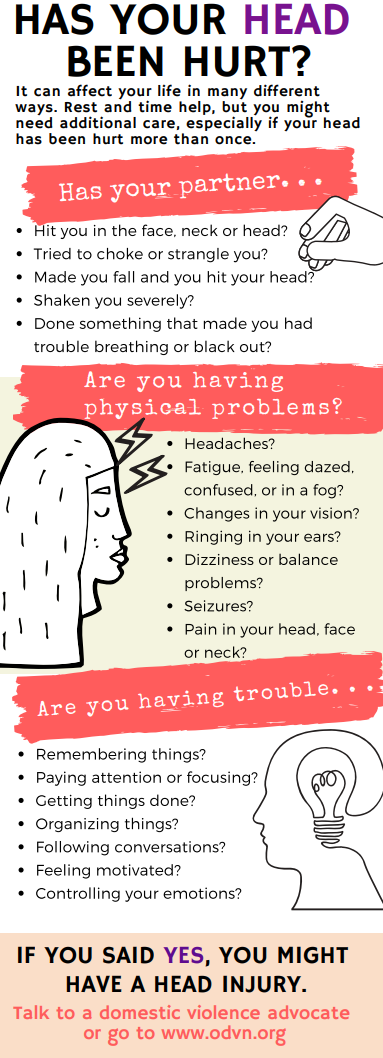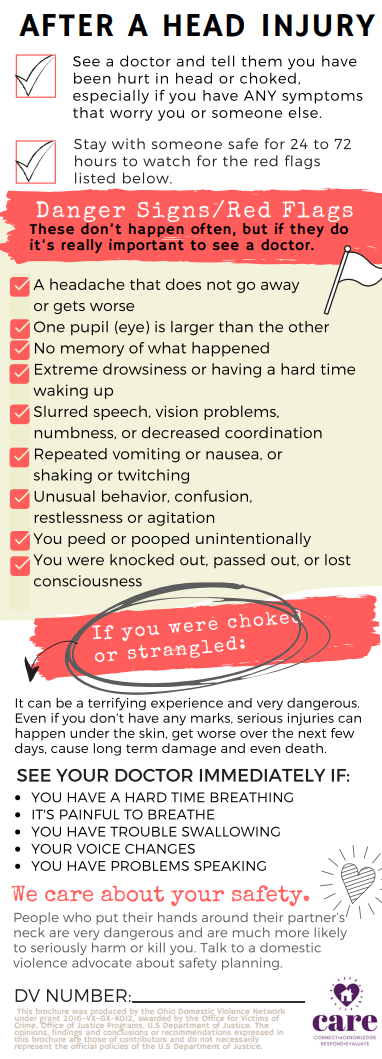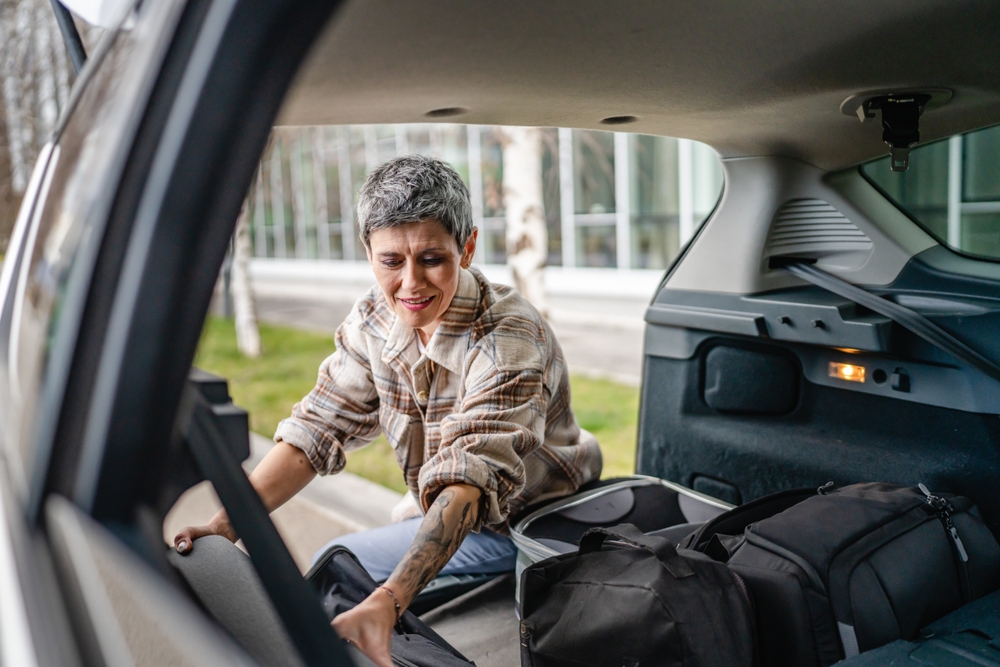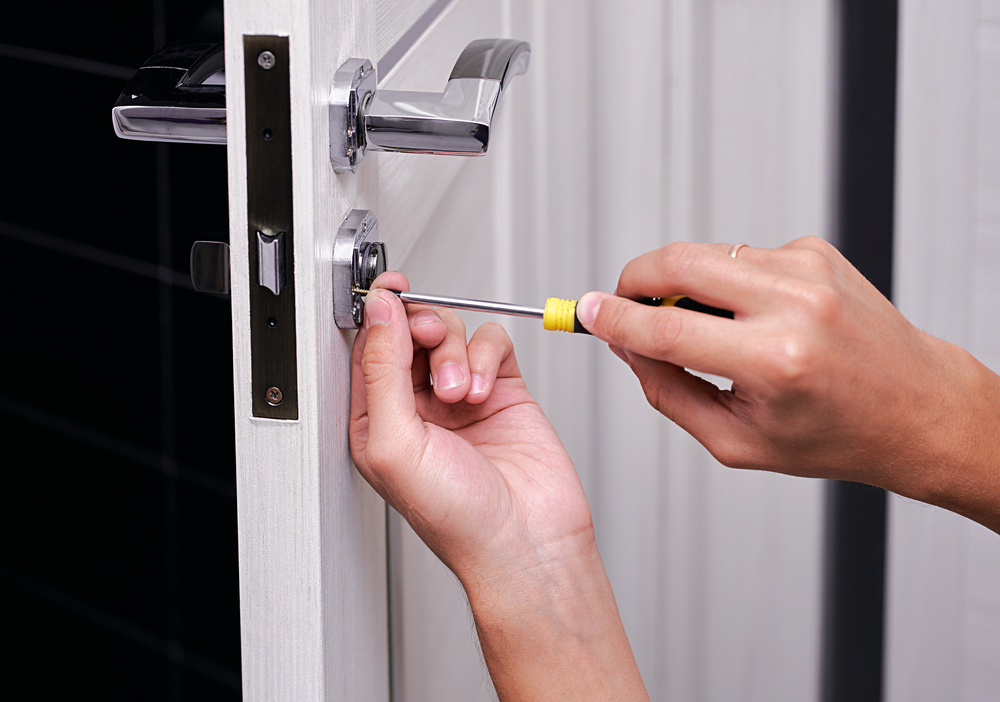Types of Abuse
Domestic violence doesn’t look the same in every relationship, because every relationship is different. One thing most abusive relationships have in common is the abusive partner does many things to have power and control of their partner. The following are the types of abuse including, but not limited to, the behaviors associated with abuse.
- Hitting, slapping, punching, kicking
- Choking, strangulation
- Burning
- Throwing or hitting with objects
- Using weapons
- Denying medical care or medication
- Stalking
- Isolation from friends and family
- Abusing pets
- Making you think you are crazy
- Yelling, name calling
- Making threats
- Belittling, blaming
- Sexual contact without consent
- Rape, incest
- Demeaning sexual remarks
- Reproductive coercion
- Controlling money, paycheck, or spending
- Stealing credit card information, running debt
- Stealing identity, social security money
- GPS tracking
- Monitoring phone, computer
Head Injuries
Head injuries can be a result of domestic violence. The resource below was created by the Ohio Domestic Violence Network (ODVN) to help you identify warning signs if you think you may have a head injury. Our advocates have been trained by ODVN to help survivors that may be suffering from traumatic brain injury with accommodations in our services where appropriate. If you are in need of help in your situation, please call our 24 hour hotline at 800-232-6505.


Red Flags
Watch out for the Red Flags of Domestic Violence. Answering “yes” to any of these questions indicates a red flag.
Multiple “yes” answers may require you to re-examine your relationship more closely.


-
Has your partner ignored your feelings?
-
Has your partner continually criticized you, called you names, or shouted at you?
-
Has your partner ridiculed or insulted your religion, race, heritage, or social class?
-
Has your partner withheld approval, appreciation, or affection as punishment?
-
Does your partner humiliate you either in private or public?
-
Does your partner refuse to socialize with you?
-
Does your partner try to keep you from working?
-
Does your partner try to control your money?
-
Does your partner control the use of protection against pregnancy?
-
Does your partner refuse to let you spend time alone?
-
Does your partner try to make all the decisions in the relationship?
-
Does your partner make excuses for not working?
-
Is it okay to spend your money, but not your partner’s?
-
Does your partner’s punishment of children seem excessive, inappropriate, or harsh?
-
Is your partner abusive to pets?
-
Does your partner blame you for everything that goes wrong?
-
When angry, does your partner blame you for everything that goes wrong?
-
Do you fear your partner’s reactions?
Safety Planning
A safety plan is a specific plan you make and update with the help of an advocate to help you manage risks from your abuser in all parts of your life: where you live, work, go to school, etc. Your safety plan also helps you develop allies – people you can turn to if you find yourself in danger.
Safety Planning When Preparing to Leave
-
Only tell a trusted friend or family member where you are going.
-
Keep all important documents in one safe place.
-
Have an extra set of keys made.
-
Change all passwords and pin numbers.
-
Have a light bag packed with essentials ready to go. Keep it in a safe place or with friends or family.
-
Try to set aside money, if possible. Start your own checking or savings account in a new bank. Use the address of a trusted friend or family member when setting up the account.
-
Be mindful your abuser may have access to your phone records. Also, turn all location services off if possible.
-
Consider talking to Turning Point about temporary shelter or other services.
Personal Safety Planning
-
Identify a trustworthy person you can rely on and keep their contact information with you.
-
Memorize hotline numbers.
-
Learn about support groups and counselors in your area that can address your needs.
-
If you have to communicate with your abuser, determine the safest way to do so and try to not be alone with them.
-
Listen to your instincts. Often the best predictor of violence is your perception of danger.
-
If you decide to return to your abuser, discuss a safety plan with someone you trust.
If You Are Staying in Your Home
-
Change your locks on all doors.
-
Arrange a safe, neutral space for all custody changes if necessary.
-
If your abuser comes to your home, do not let them in. Keep all doors locked and call the police.
Tips for Court
If you will be entering and leaving court buildings where your abuser will be, it is important for you to plan for safety. Here are some tips:
-
Bring a support person and an advocate, if you can.
-
Ask that the abuser be required to stay 15 minutes after the hearing so you can leave safely.
-
Ask for a bailiff or security officer to escort you in and out of the building.
-
Ask to wait in a separate waiting area from the abuser.
-
Have a plan with a support person or an advocate to meet after court and re-evaluate your safety plan based on what happened at court, and to also get support.



Checklist: What to take with you when you leave.
-
Identification/driver’s license
-
Keys – house/car/office
-
Birth certificates for you and your children
-
Medical records
-
Social Security cards
-
Protection orders/restraining orders
-
Insurance cards
-
Medications
-
School records/shot records
-
Money, checkbook, ATM, debit, or credit cards
-
Lease/rental agreement or deed
-
Divorce papers
-
Important sentimental items
Safety Planning with Children




Safety Planning in the Home
A safety plan should include ways that your children can stay safe when violence is happening in your home. It is key to remember that if the violence is escalating, you should avoid running to the children because your partner may hurt them as well.
-
Teach your children when and how to call 911.
-
Instruct them to leave the home if possible when things begin to escalate, and where they can go.
-
Come up with a code word that you can say when you need to leave the home in case of an emergency – make sure they know not to tell others what the word means (this technique works well with older children).
-
In the house: Identify a small room they can go to when they’re afraid and something they can think about when they are scared.
-
Instruct them to stay out of the kitchen, bathroom, and other areas where there are items that could be used as weapons.
-
Teach them that although they want to protect their parent, that they should never intervene.
-
Help them to make a list of people that they are comfortable talking and expressing themselves to.
-
Enroll them in a counseling program.
Planning for Unsupervised Visits
If you have separated from an abusive partner and are concerned for your children’s safety when they visit your ex, developing a safety plan for while they are at their home can be beneficial.
-
Brainstorm with your children (if they are old enough) to come up with ways they can stay safe using the same model as you would for your own home. Have them identify where they can get to a phone, how they can leave the house, and where they can go.
-
If it’s safe to do, send a cellphone with the children to be used in emergency situations – this can be used to call 911, a neighbor, of you if they need.
Planning for a Safe Custody Exchange
-
Avoid exchanging custody at your home or your ex-partners’s home.
-
Meet in a safe, public place such as a restaurant, bank/other area with lots of cameras, or even near a police station.
-
Bring a friend or relative with you to the exchanges, or have them make the exchange if it is safe.
-
Perhaps plan to have your ex-partner pick the children up from school at the end of the day after you drop them off in the morning – this eliminates the chances of of seeing each other.
-
Emotional safety plan as well – figure out something to do before the exchange to calm any nervous feelings, and something after to focus on yourself or the kids, such as going to a park or doing a fun activity.
Planning for After You Leave
-
Alert anyone you can about the situation: school authorities like a counselor, receptionist, teachers, principal, sports instructors, and other caretakers.
-
Talk to these people about what’s going on: if you have a protection order or restraining order, who is allowed to pick them up, etc.
How to Have These Conversations
Let your child know that what’s happening is not their fault and that they didn’t cause it. Let them know how much you love them and that you support them no matter what. Tell them that you want to protect them and that you want everyone to be safe, so you have come up with a plan to use in case of emergencies. It’s important to remember that when you’re safety planning with a child, they might tell this information to an abusive partner, which could make the situation more dangerous (ex. “Mom said to do this if you get angry.”) When talking about these plans with your child, use phrases such as, “We’re practicing what to do in an emergency,” instead of using phrases that directly reference the abusive partner or suggest that the child’s behavior could prevent harm. This way, you can ensure their safety while minimizing the risk of escalation. Remember, your well-being and the well-being of your child are of utmost importance, and there are resources available to support you both during this challenging time.
